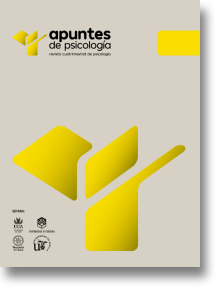The Say-Do-Say correspondence in semi-natural contexts: A pilot study
DOI:
https://doi.org/10.55414/paf0zt37Keywords:
Say-Do-Say correspondence , Psychological interventions , Semi-natural context , Observational methodologyAbstract
The Say-Do-Say correspondence is defined as the coincidence relationship between what a person says they will do, what they subsequently do, and what they finally report having done. Despite the relevance of this phenomenon in the clinical setting, it has been scarcely investigated. The two objectives of the present work were: (1) evaluate whether the proposed methodology is adequate to measure correspondence; (2) analyze whether the delay variable affects the establishment of correspondence. To do this, a pilot study was carried out using a quasi-experimental design with two groups (Delay group and No-Delay group) and nine single-case studies were carried out, measuring the correspondence in five behaviors through questionnaires and an observational methodology. In the Delay group, each of the phases was measured with a time difference of one week, while in the No-Delay group all measurements were performed on the same day. The methodology used seemed appropriate to make a first approach to the phenomenon in semi-natural contexts, although certain limitations were found that must be taken into account in future studies. Likewise, it was found that the delay affected the establishment of the three types of correspondence relationship (Say-Do, Do-Say, Say-Say).
References
Baer, R.A. y Detrich, R. (1990). Tacting and manding in correspondence training: Effects of child selection of verbalization. Journal of the Experimental Analysis of Behavior, 54(1), 23-30. https://doi.org/10.1901/jeab.1990.54-23
Baer, R.A., Detrich, R. y Wenninger, J. (1988). On the functional role of verbalization in correspondence training procedures. Journal of Applied Behavior Analysis, 21(4), 345-356. https://doi.org/10.1901/jaba.1988.21-345
Bem, S.L. (1967). Verbal self-control: The establishment of effective self-instruction. Journal of Experimental Psychology, 74(4), 485- 491. https://doi.org/10.1037/h0024822
Bevill-Davis, A., Clees, T.J. y Gast, D.L. (2004). Correspondence training: A review of the literature. Journal of Early and Intensive Behavior Intervention, 1(1), 13-26. http://doi.org/10.1037/h0100276
Birch, D. (1966). Verbal control of nonverbal behavior. Journal of Experimental Child Psychology, 4, 266-275. https://doi.org/10.1016/0022-0965(66)90027-0
Brodsky, G. (1967). The relation between verbal and non-verbal behavior change. Behaviour Research & Therapy, 5, 183-191. https://doi.org/10.1016/0005-7967(67)90033-2
Cohen, J. (1960). A coefficient of agreement for animal scales. Educational and Psychological Measurement, 20(1), 37-46. https://doi.org/10.1177/001316446002000104
Freire, N.N. y de Medeiros, C.A. (2018). Correspondência verbal na Terapia Analítica Comportamental: Contribuições da pesquisa básica. Revista Brasileira de Terapia Comportamental e Cognitiva, 20(1), 40-57. https://doi.org/10.31505/rbtcc.v20i1.1136
Friedman, A.G., Greene, P.G. y Strokes, T. (1990). Improving dietary habits of children: effects of nutrition education and correspondence training. Journal of Behavior Therapy and Experimental Psychiatry, 21(4), 263-268. https://doi.org/10.1016/0005-7916(90)90027-I
Froxán-Parga, M.X., Ávila-Herrero, I., Trujillo-Sánchez, C., Serrador-Díez, C. y Núñez de Prado-Gordillo, M. (2019). Análisis de la correspondencia Decir-Hacer-Reportar en terapia: un estudio piloto. Journal of Behavior, Health & Social Issues, 11(2), 55-68. http://doi.org/10.22201/fesi.20070780.2019.11.2.75671
Herruzo, J. y Luciano, C. (1994). Procedimientos para establecer la “correspondencia decir-hacer”. Un análisis de sus elementos y problemas pendientes. Acta Comportamentalia, 2(2), 192-218.
Herruzo, J., Luciano, M.C. y Pino, M.J. (2001). Disminución de conductas disruptivas mediante un procedimiento de correspondencia «Decir-Hacer». Acta Comportamentalia, 9, 145-162.
Israel, A.C. (1978). Some thoughts on correspondence between saying and doing. Journal of Applied Behavior Analysis, 11(2), 271-276. https://doi.org/10.1901/jaba.1978.11-271
Landis, J.R. y Koch, G.G. (1977). The measurement of observer agreement for categorical data. Biometrics, 33(1), 159-174. https://doi.org/10.2307/2529310
Lovaas, O.I. (1961). Interaction between verbal and nonverbal behavior. Child Development, 32, 329-336. https://doi.org/10.2307/1125947
Lovaas, O.I. (1964). Control of food intake in children by reinforcement of relevant verbal behavior. Journal of Abnormal and Social Psychology, 68(6), 672-678. http://doi.org/10.1037/h0047612
Luciano, M.C. (1992). Algunos significados aplicados de los tópicos de investigación básica conocidos como relaciones de equivalencia, decir y hacer, y sensibilidad e insensibilidad a las contingencias. Análisis y Modificación de Conducta, 18(62), 805-859.
Luciano, M.C., Herruzo, J. y Barnes-Holmes, D. (2001). Generalization of Say-Do correspondence. The Psychological Record, 51, 111-130. https://doi.org/10.1007/BF03395389
Luciano, M.C., Molina Cobos, F.J. y Gómez, I. (2000). Say-Do-report training to change chronic behaviors in mentally retarded subjects. Research in Developmental Disabilities, 21, 355-366. https://doi.org/10.1016/S0891-4222(00)00048-2
Luria, A.R. (1961). The role of speech in the regulation of normal and abnormal behaviour. Liverwrigh Publishing Corporation.
Paniagua, F., Pumariega, A. y Black, S. (1988). Clinical effects of correspondence training in the management of hyperactive children. Behavioral Residential Treatment, 3(1), 19-40. http://doi.org/10.1002/bin.2360030103
Serrador, C. (2018). Análisis y evaluación de las variables implicadas en la ruptura de la correspondencia Decir-Hacer-Reportar (Tesis de maestría). Universidad De Guadalajara, Jalisco, México.
Sherman, J.A. (1964). Modification of nonverbal behavior through reinforcement of related verbal behavior. Child Development, 35(3), 717-723. https://doi.org/10.2307/1126497
Downloads
Published
Issue
Section
License
Copyright (c) 2024 Apuntes de Psicología

This work is licensed under a Creative Commons Attribution-NonCommercial-NoDerivatives 4.0 International License.


















